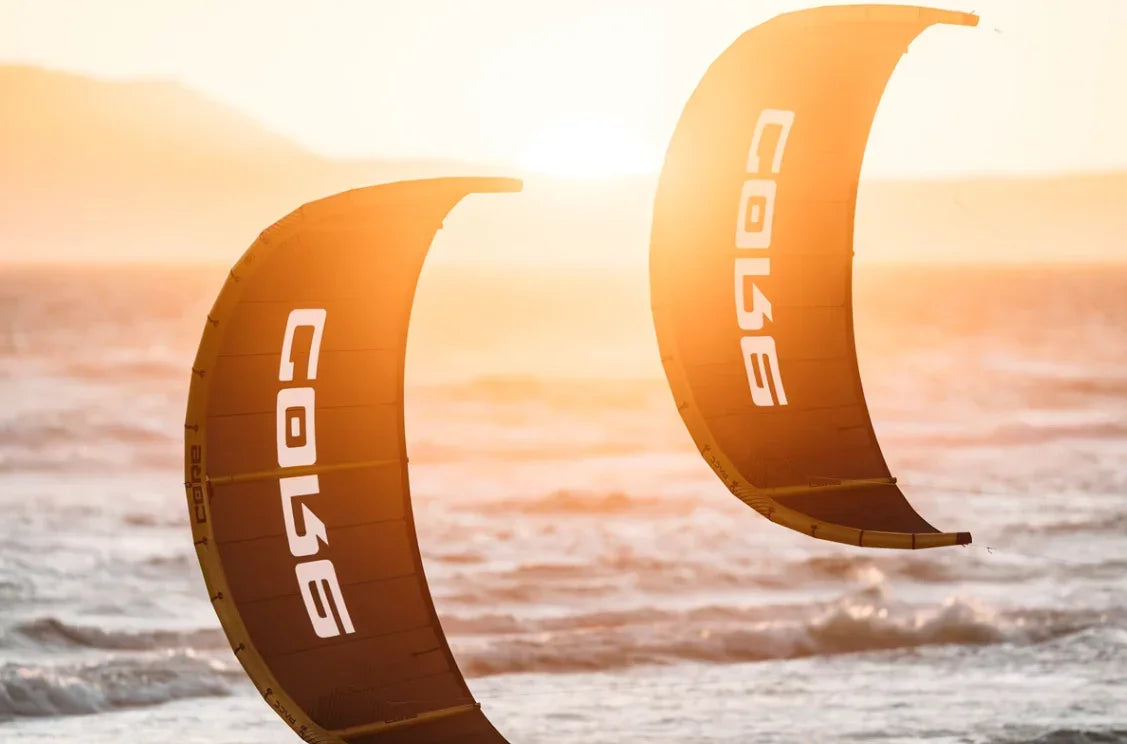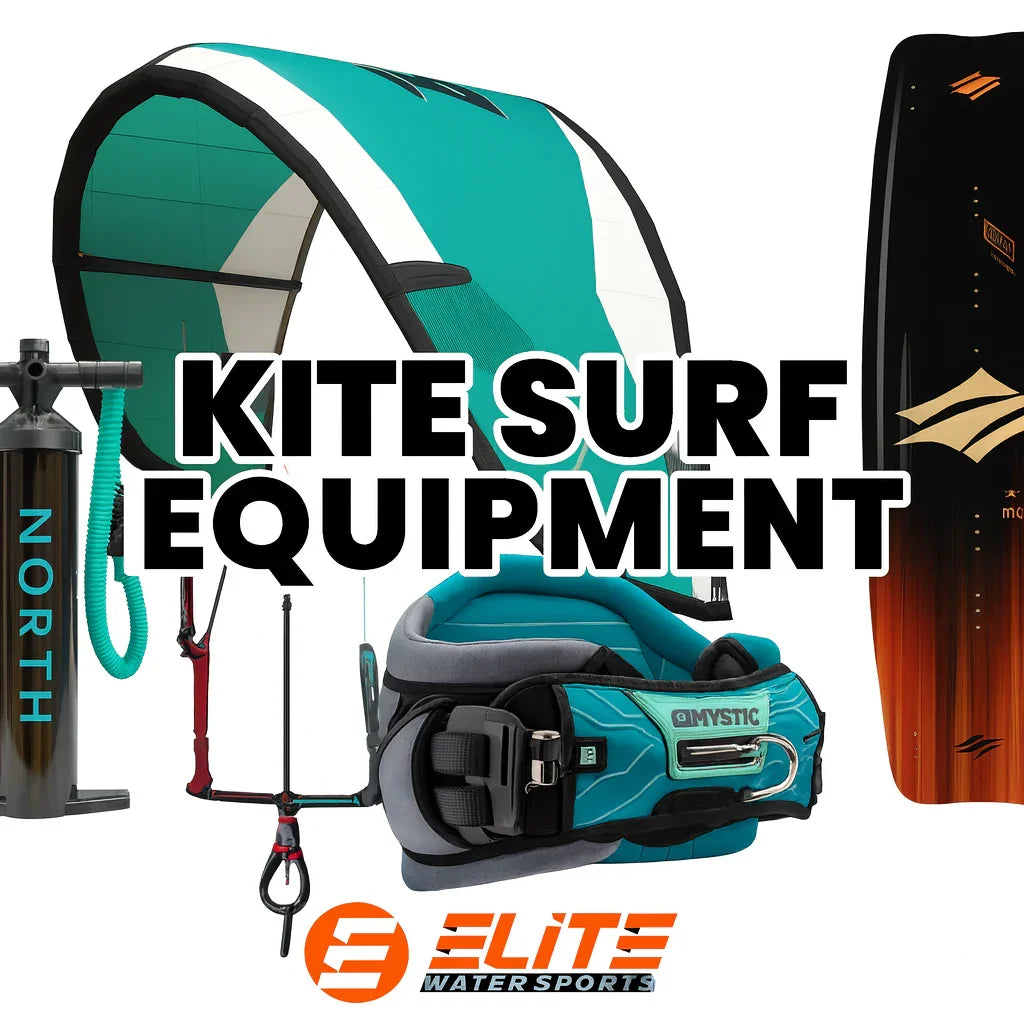ELITE WATERSPORTS
Last updated 02-16-2025
Unlock Your Kite’s Full Potential: Why Tuning Matters
Everything you need to know.

Unlock Your Kite’s Full Potential: Why Tuning Matters
Kiteboarding is all about control, power, and flow, but most riders never adjust their gear beyond what comes straight out of the bag. They roll up to the beach, set up their kite, and hit the water—never realizing that a simple adjustment to their bar size, line length, or kite settings could completely change their ride.
💬 Aaron’s Take:
"The features we have at our fingertips—the ability to adjust our kites, bars, and line lengths—it’s all right there, but nobody really takes advantage of it! Every single kite brand builds these options in, but I rarely see anyone making adjustments to match their riding style."
So why does this matter? Because your kite setup controls how fast, powerful, and responsive your kite feels. The difference between struggling with a trick and landing it clean could be as simple as switching to a smaller bar, tweaking your wingtip settings, or riding with a shorter set of lines.


Table Of Contents
- The Problem: Wasted Potential on the Water
- How Your Setup Affects Your Ride
- Line Length – The Hidden Factor That Can Change Everything
- How to Test & Find Your Perfect Setup
- Final Thoughts & The Biggest Takeaways
The Problem: Wasted Potential on the Water
Most riders experience some level of frustration when trying to progress—whether it’s:
❌ Feeling like the kite is too slow or unresponsive
❌ Oversteering or losing control in the middle of a trick
❌ Struggling to keep power steady in gusty conditions
❌ Wiping out because the kite isn’t where you expect it to be
What many don’t realize is that these aren’t just skill issues—they’re often caused by riding the wrong setup for their style, conditions, or progression level.
💬 Aaron’s Challenge to Riders:
"If you feel stuck—like you’re always crashing a trick or losing control—your settings might be the reason. Change just one thing, and suddenly, everything clicks."


What This Guide Covers & Why It Matters
This is your ultimate guide to dialing in your kite setup for better control, smoother tricks, and more progression on the water. By the time you finish this blog, you’ll know exactly how to adjust your bar size, line length, and kite settings to suit your riding style and the conditions you face.
👉 Bar Sizes – How different bar lengths affect your kite’s speed, power, and responsiveness
👉 Kite Settings – The right adjustments to fine-tune your kite’s behavior in different conditions
👉 Line Lengths – How shorter vs. longer lines impact your turning speed, power, and overall control
👉 Real-World Applications – How pro riders tweak their setup to land more tricks and ride more efficiently
Whether you’re a beginner struggling with control, an intermediate rider looking for smoother power delivery, or an advanced kiteboarder fine-tuning for max progression, this guide will show you how small adjustments can make a massive difference.
How Your Setup Affects Your Ride
Every time you change your bar size, kite settings, or line length, you’re affecting three key things:
✅ Turning Speed – Affects how quickly your kite moves across the window
✅ Power & Lift – Determines how much pull you get during jumps & tricks
✅ Control & Stability – Impacts how predictable and steady your kite feels
Most riders assume these factors are baked into their kite’s design, but in reality, they’re adjustable—you just have to know how to tweak them to your advantage.
🚀 Section 2: Understanding Kite Bar Sizes & How They Affect Your Ride
Bar Size – The Most Overlooked Adjustment in Kiteboarding
Most kiteboarders grab whatever bar came with their kite and never think twice about it. But did you know that switching your bar size can completely change how your kite performs?
💬 Aaron’s Take:"Most riders just grab a bar, hook in, and send it. But bar size directly affects how fast your kite moves, how much control you have, and even how easy it is to land tricks. If you feel like your kite is too slow, too twitchy, or just out of control—bar size is one of the first things to look at."
🔹 What Does Bar Size Actually Do?
Bar size controls how much input you give to your kite with each movement. A bigger bar means more leverage, which makes the kite turn faster. A smaller bar means less movement, which gives you finer control.
👉 Bigger Bar = Faster Turning & More Responsive Kite
👉 Smaller Bar = Slower Turns & More Stability
🔍 Quick Reference: What Bar Size Should You Use?
✅ 40-45cm Bar → Best for small kites (5m-9m), gives more control & stability
✅ 50-55cm Bar → All-around bar for most kites (10m-14m), good balance of control & speed
✅ 60-62cm Bar → Best for big kites (15m+), makes sluggish kites turn much faster
💬 Aaron’s Breakdown: "If your kite feels slow and unresponsive, grab a bigger bar and watch how fast it starts whipping through the sky. But if you’re oversteering and losing control during tricks—especially in rotations or kite loops—try a smaller bar and watch how much smoother everything gets."

🔹 Real-World Scenarios: When to Adjust Your Bar Size
Still not sure how bar size affects your ride? Let’s break it down with some real-world examples:
🏄♂️ Scenario 1: You’re Struggling to Keep Up in Light Wind
💡 Fix: Use a bigger bar to speed up turns and generate more power.
💬 Aaron’s Tip:
"If the wind is light and your kite feels sluggish, a bigger bar can help you work the kite harder and keep moving."
🔄 Scenario 2: Your Kite Keeps Oversteering During Tricks
💡 Fix: Switch to a smaller bar for finer control.
💬 Aaron’s Tip:
"Ever thrown a backroll and felt like your kite just took off in a random direction? That’s oversteering. A smaller bar will smooth things out and keep your kite locked where you want it."
💨 Scenario 3: You Want Faster Kite Loops for Boosting Big Air
💡 Fix: Use a bigger bar to make the kite whip around quicker.
💬 Aaron’s Tip:
"If you’re sending kite loops and they feel slow and weak, go bigger on the bar and watch how much snappier they get."
🔹 The Pro Move: Testing Different Bars for Maximum Progression
If you’ve been riding the same bar size for years, it’s time to start experimenting. Here’s how to test what works best for you:
✅ Borrow a different bar size from a friend or shop and test how it feels
✅ Try a bigger bar in light wind to see if you get more power and control
✅ Use a smaller bar when learning new tricks to reduce oversteering
💬 Aaron’s Final Word:
"If you’re struggling with control, landing tricks, or generating power—don’t blame your kite. Try adjusting your bar size first. It could be the small change that makes the biggest difference."
🔹 When & Why You Should Adjust Your Kite Settings
🏄♂️ Scenario 1: You’re Learning a New Trick & Your Kite Feels Too Fast
💡 Fix: Move the setting closer to the center to slow the kite down.
💬 Aaron’s Tip: "If you’re trying to dial in a backroll and your kite keeps flying out of place, this will stabilize it."
💨 Scenario 2: You Want More Pop & Faster Response for Kite Loops
💡 Fix: Move the setting closer to the wingtip for faster turning.
💬 Aaron’s Tip:
"If your kite loops feel sluggish, try shifting to the outer setting—it’ll whip around way quicker."
🌊 Scenario 3: You’re Riding Waves & Need More Drift
💡 Fix: Use the middle or inner setting for a smoother, more predictable feel.
💬 Aaron’s Tip:
"Wave riding is all about control. If your kite is reacting too quickly, move the settings inward so you can focus on your line without the kite overcorrecting."
🔹 Pro Move: How to Experiment & Find Your Perfect Setup
Riders often assume that their kite is locked into one feel, but you can fine-tune it for different conditions.
✅ Try shifting your settings one step at a time and take notes on how the kite responds.
✅ Test different setups in different wind conditions—light wind might need a faster setting, while gusty wind may feel better with a slower setting.
✅ If you’re struggling with a trick or control, adjusting your settings should be one of the first things you try.
💬 Aaron’s Final Word:
"If your kite isn’t feeling right, the first thing I’d do is look at the settings. It takes five seconds to change, but it could be the thing that unlocks your next level of progression."
Line Length – The Hidden Factor That Can Change Everything
Why Line Length is the Most Underrated Adjustment in Kiteboarding
Most riders focus on kite size, bar width, and wind conditions, but almost nobody thinks about their line length. What they don’t realize is that line length can completely transform the way your kite delivers power, turns, and responds to input.
💬 Aaron’s Take:
"Line length is one of the biggest game-changers, but almost nobody experiments with it. Every brand sells kites with a 'standard' line length, but what they don’t tell you is you can (and should) adjust it based on how you ride. It can be the difference between struggling and absolutely sending it."
🔹 What Line Length Actually Does
Your kite’s power, turning speed, and responsiveness are all affected by how long your lines are. Longer lines = more power buildup. Shorter lines = more direct control.
🔍 Quick Breakdown: What Different Line Lengths Do
✅ Short Lines (18m-20m) → Fast, responsive, less power
- Faster turning
- Great for foiling, waves, and wakestyle
- Less power buildup but better for technical riding
✅ Medium Lines (22m-24m) → All-around balance of power & control
- Standard for most kites
- Works well in most conditions
- Good for progression & versatility
✅ Long Lines (25m-30m+) → More power, slower turns, bigger jumps
- Ideal for light wind sessions
- Builds more power before releasing
- Slower but more controlled kite movement
💬 Aaron’s Example:
"Think about it like this—longer lines give your kite more room to build up energy before you pull. That’s why guys in light wind or boosting big air often use longer lines—it adds extra power. But if you’re foiling or riding waves, you want shorter lines so the kite reacts instantly."


🔹 Real-World Scenarios: When to Adjust Your Line Length
💨 Scenario 1: You’re Struggling in Light Wind
💡 Fix: Increase your line length to generate more power.
💬 Aaron’s Tip: "If the wind is light and your kite feels underpowered, throw on some 3-5m extensions and you’ll feel a big difference."
🏄♂️ Scenario 2: You’re Kiting in the Waves & Need Faster Turns
💡 Fix: Shorten your lines for quicker reaction times.
💬 Aaron’s Tip: "In the surf, you want your kite to be super responsive so it’s exactly where you need it when you’re on a wave. Cutting your lines down will make a huge difference."
🪂 Scenario 3: You Want to Boost Bigger Jumps
💡 Fix: Use longer lines to maximize your lift.
💬 Aaron’s Tip: "If you want the biggest possible jumps, longer lines will help you get way more lift because the kite has time to generate power before it pulls."
🚀 Scenario 4: You’re Foiling & Need Precision
💡 Fix: Shorten your lines to 16m-18m for max control.
💬 Aaron’s Tip: "When I’m foiling, I love riding 16m lines. It makes the kite super responsive and lets me keep full control in light wind."
🔹 The Pro Move: Experimenting with Line Length for Maximum Performance
Want to dial in the perfect setup? Here’s how to test different line lengths and see what works best for you:
✅ Use line extensions (3m-5m) to test different lengths without committing to cutting your lines.
✅ Try shorter lines in high wind to see if you get better control and stability.
✅ Use longer lines in light wind and see how much more power your kite generates.
💬 Aaron’s Final Word: "Line length is one of the easiest things to tweak, but so few people play around with it. Once you start dialing it in, you’ll never go back to stock settings."
How to Test & Find Your Perfect Setup
Stop Guessing—Start Dialing in Your Perfect Kite Setup
By now, you know that bar size, kite settings, and line length all play a major role in how your kite performs. But reading about it is one thing—actually testing and feeling the difference on the water is where the magic happens.
Most riders never take the time to experiment with their gear, which means they’re probably riding a setup that isn’t fully optimized for their style or conditions. That ends today.
💬 Aaron’s Take: "So many riders just accept whatever setup they’re given and never mess with it. But if you want to progress, land new tricks, or even just have an easier time on the water, you have to test different setups and figure out what actually works for you."
🔹 The Step-by-Step Process for Testing Your Kite Setup
If you’re serious about unlocking your best ride, follow this process:
1️⃣ Start with One Variable at a Time
Don’t change everything at once—or you’ll have no idea which adjustment actually made the difference. Instead:
✅ Day 1: Test a different bar size (bigger or smaller)
✅ Day 2: Change your wingtip settings (try the outer and inner positions)
✅ Day 3: Adjust line length (add or remove extensions)
💬 Aaron’s Tip:
"If you’re making multiple changes at once, you won’t know which one is actually helping or hurting. Make small tweaks, ride, and take notes—it’ll make a massive difference."

2️⃣ Test in Different Wind Conditions
Kite tuning isn’t a one-size-fits-all thing. A setup that works in 10 knots might feel horrible in 25 knots. Make sure you:
✅ Test different settings on light wind days vs. strong wind days
✅ See how adjustments feel in gusty vs. stable wind conditions
✅ Compare how your kite behaves in flat water vs. waves
💬 Aaron’s Tip: "Your perfect setup in 15 knots won’t be the same as 25 knots. Make adjustments based on the wind—don’t just set it and forget it."
3️⃣ Keep Notes on What Feels Best
Riding with different setups is great, but if you don’t track what works, you’ll forget what actually felt better.
💡 What to Write Down After Each Session:
- What settings did you use? (Bar size, wingtip setting, line length)
- How did your kite feel? (Sluggish? Twitchy? Balanced? Fast?)
- What wind speed & conditions were you in?
- Did the change make things better or worse?
💬 Aaron’s Tip:
"Most pros keep notes on their setups because what feels perfect one day might not feel great in different conditions. Write down what works, and soon you’ll know exactly how to set up your kite every time."
🔹 The Pro Move: Having Multiple Setups Ready to GoOnce you know what works for you, take it to the next level by keeping different setups ready for different conditions.
✅ Have a small & large bar on hand for changing your kite’s responsiveness
✅ Use different line extensions so you can quickly adjust power delivery
✅ Dial in the best wingtip settings for each kite in your quiver
💬 Aaron’s Final Word: "The riders who progress the fastest are the ones who take the time to dial in their setup. If you’ve been struggling with control, power, or landing tricks—start experimenting, and you’ll be shocked at how much easier everything becomes."
Final Thoughts & The Biggest Takeaways
The Difference Between Struggling & Progressing is in Your Setup
Most riders blame themselves when they struggle with progression, but more often than not, it’s their gear holding them back. The difference between landing that trick or crashing, between feeling in control or out of sync—it all comes down to fine-tuning your kite setup.
💬 Aaron’s Take: "You could be riding the perfect kite for you, but if it’s not set up correctly, you’re not getting the most out of it. Small tweaks to your bar size, line length, or wingtip settings can make a huge difference in how the kite responds. If you’re struggling, don’t assume it’s all on you—start adjusting your gear and see how much easier everything gets."

🔹 The 3 Biggest Takeaways from This Guide
✅ 1. Bar Size Controls How Fast Your Kite Turns
- Larger bar = faster, more reactive kite (good for big air & loops)
- Smaller bar = slower, more controlled kite (ideal for freestyle & beginners)
✅ 2. Wingtip Settings Control Your Kite’s Stability & Responsiveness
- Outer settings = faster, looser, easier turning
- Inner settings = slower, more stable, better for control
✅ 3. Line Length Affects Power, Lift & Precision
- Longer lines = more power, slower turns, better for boosting big air
- Shorter lines = quicker response, better for waves, foiling & technical tricks
💬 Aaron’s Final Challenge to Riders: "Next time you hit the water, make a small adjustment—try a different bar size, move your wingtip settings, or test a different line length. You might be one simple tweak away from unlocking your next level of riding."
🔹 Want Help Dialing in Your Setup? Let’s Talk!
At Elite Watersports, we help riders get the most out of their gear. Whether you need advice on tuning, want to test different setups, or are looking for the best kiteboarding gear, we’ve got you covered.
📍 Visit Us In-Shop or Contact Us Online
📞 Call us: 727-800-2202
📩 Email us: ride@elitewatersports.com
🌐 Check out our gear & lessons: Elite Watersports Website
Where to take kiteboarding lessons in Florida.
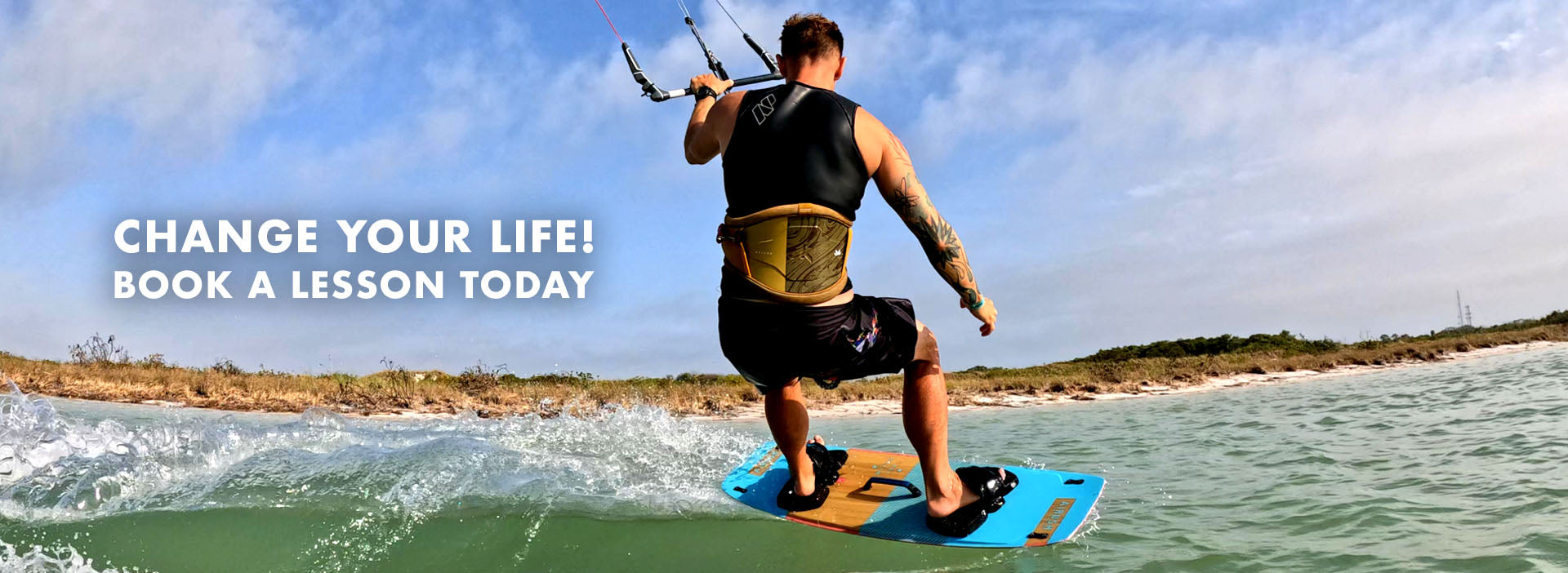 Reserve A Lesson
Reserve A LessonThe nearest kiteboarding shop and kite school that services Dunedin and Clearwater is Elite Watersports located in St Petersburg. Give us a call and we can get you up and riding in no time. We teach kitesurfing lessons at Skyway beach a short drive south of Dunedin. Our condions are also beginner friendly and perfect for learning.
Call us for more info on kiteboarding in Florida.
Elite Watersports has served the Tampa and St Petersburg area for years. They offer kiteboarding and wingsurfing lessons. They also have a retail shop equpit with all of the latest kitesurfing gear.
If you need help give us a call. .
(727)-800-2202
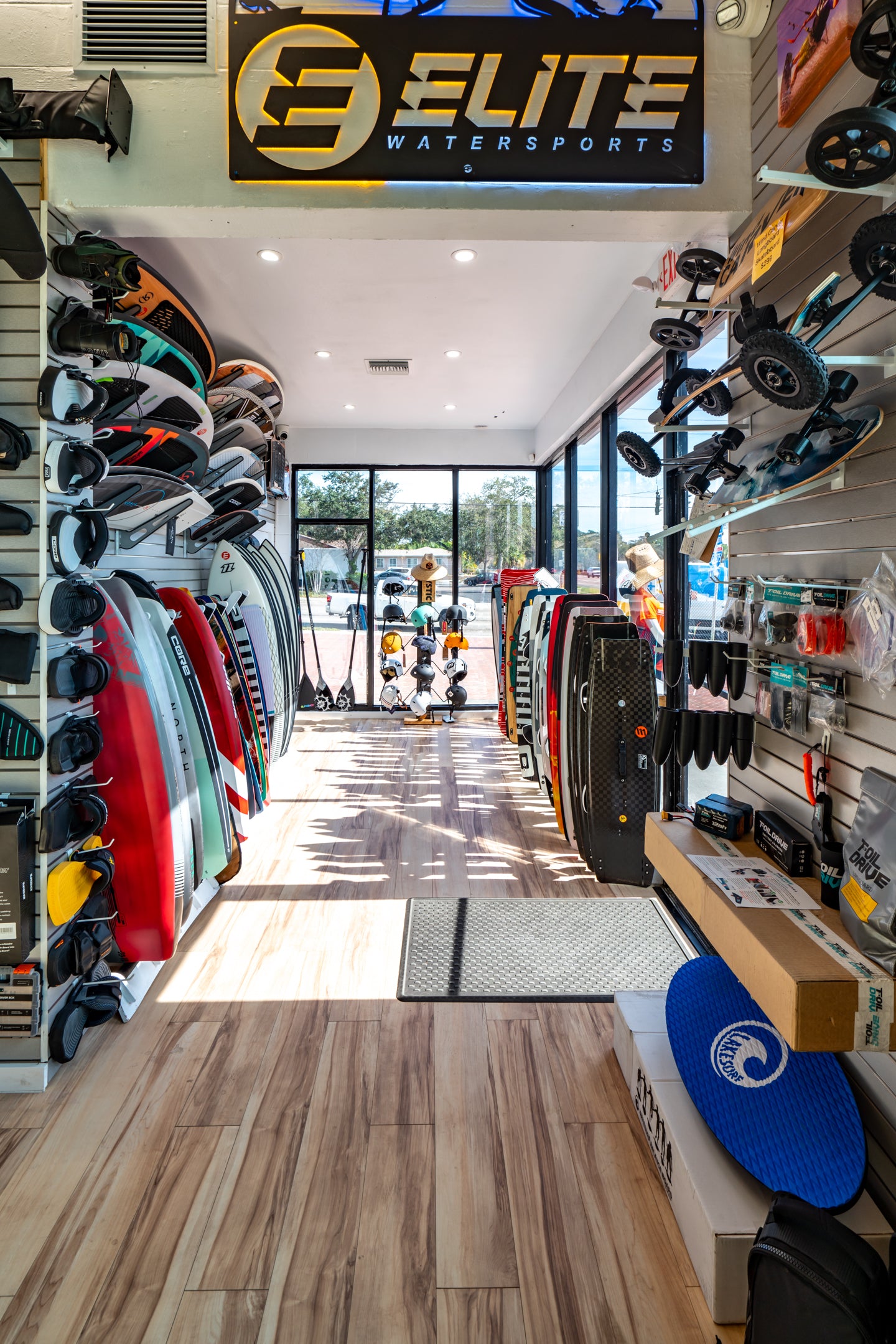
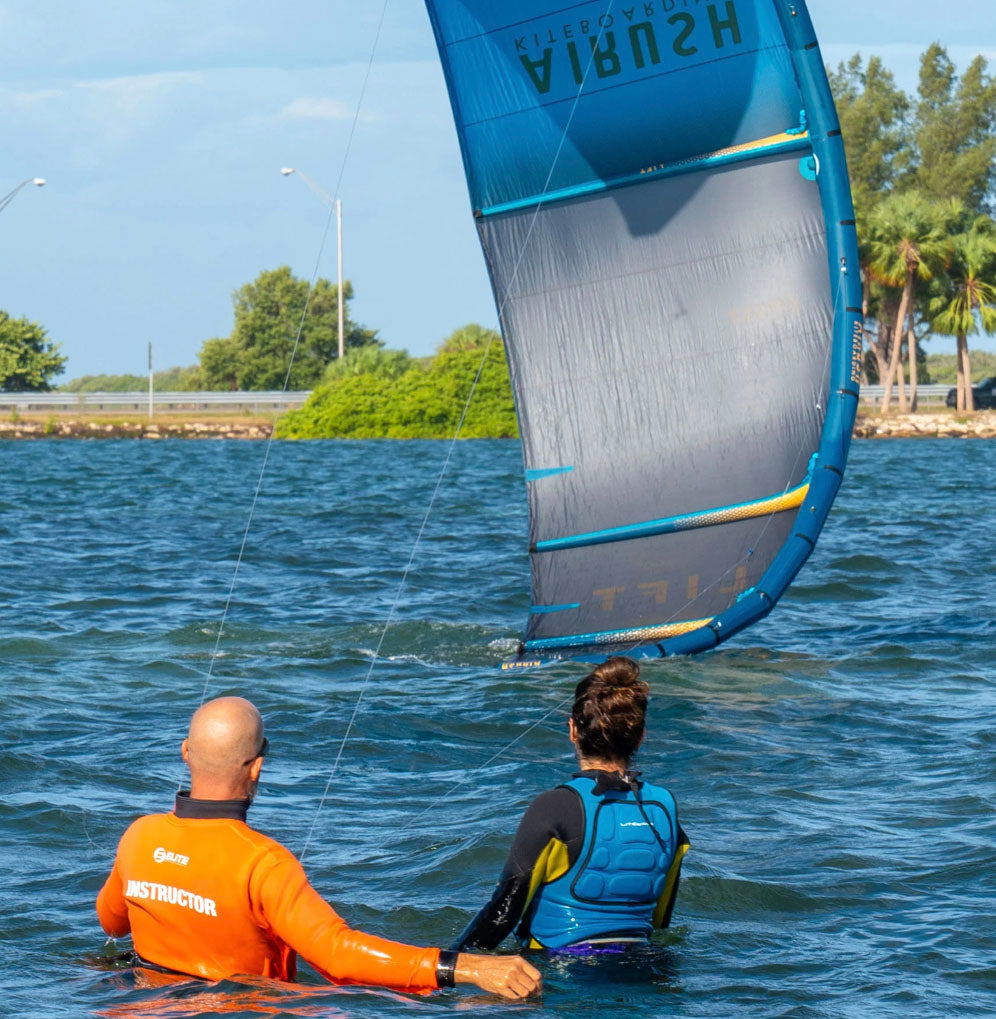
Author

Ryan "Rygo" Goloversic
Rygo is a globally recognized kiteboarder, Airush team rider and an advocate for wakestyle kiteboarding. When he's not writing articles or producing kite videos you can catch him competing on the KPLxGKA world tour or grinding it out in the gym
Tags
Kiteboarding self Rescue
You May Also Like
Want To learn more about kiteboarding?
Follow us to receive the latest update on our journey experience

